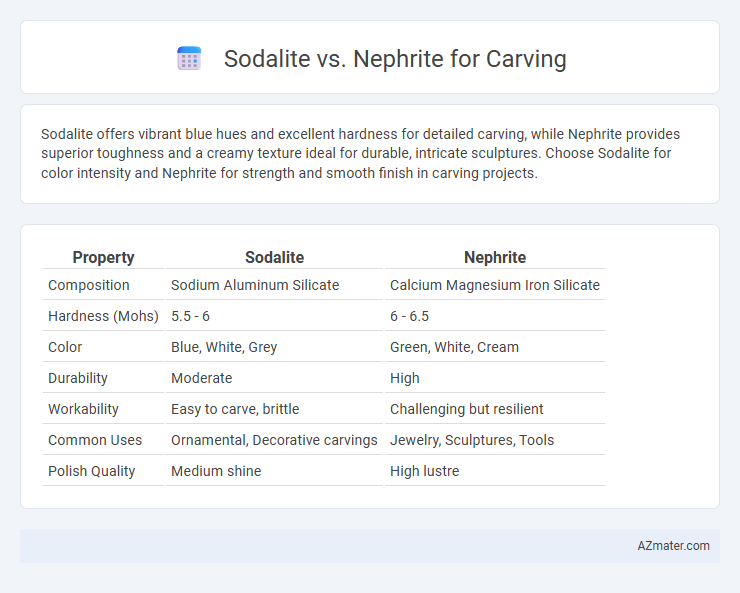Sodalite offers vibrant blue hues and excellent hardness for detailed carving, while Nephrite provides superior toughness and a creamy texture ideal for durable, intricate sculptures. Choose Sodalite for color intensity and Nephrite for strength and smooth finish in carving projects.
Table of Comparison
| Property | Sodalite | Nephrite |
|---|---|---|
| Composition | Sodium Aluminum Silicate | Calcium Magnesium Iron Silicate |
| Hardness (Mohs) | 5.5 - 6 | 6 - 6.5 |
| Color | Blue, White, Grey | Green, White, Cream |
| Durability | Moderate | High |
| Workability | Easy to carve, brittle | Challenging but resilient |
| Common Uses | Ornamental, Decorative carvings | Jewelry, Sculptures, Tools |
| Polish Quality | Medium shine | High lustre |
Introduction to Sodalite and Nephrite
Sodalite, a rich royal blue mineral with white veining, is prized for its vibrant color and ease of carving, making it a popular choice for ornamental objects and jewelry. Nephrite, a type of jade known for its toughness and creamy green to brown hues, offers exceptional durability and smooth texture, ideal for intricate carvings and traditional sculptures. Comparing sodalite and nephrite reveals differences in hardness, aesthetic appeal, and carving techniques, influencing artists' material selection depending on desired finish and durability.
Geological Origins and Composition
Sodalite is a deep blue tectosilicate mineral primarily composed of sodium, aluminum, silicon, oxygen, and chlorine, formed in silica-poor igneous rocks such as nepheline syenites. Nephrite, a form of microcrystalline actinolite, is a calcium magnesium iron silicate found in metamorphic environments like serpentinized ultramafic rocks and often displays a creamy to jade-green color. The geological origin and distinct mineral compositions of sodalite and nephrite influence their hardness and carving suitability, with nephrite's fibrous structure providing superior toughness compared to the more brittle sodalite.
Color and Appearance Differences
Sodalite displays a rich royal blue color often interspersed with white calcite veins, giving it a striking and vibrant appearance ideal for decorative carving. Nephrite varies from creamy white to deep green, offering a more subdued, smooth, and waxy texture that emphasizes organic and natural aesthetics in carvings. The vibrant contrast in sodalite versus the earthy, translucent depth of nephrite significantly influences the visual impact and style of the carved piece.
Hardness and Durability Compared
Sodalite has a Mohs hardness of 5.5 to 6, making it moderately soft and suitable for detailed carving but more prone to scratches and chips than harder stones. Nephrite, a type of jade, possesses a higher hardness of 6 to 6.5 combined with exceptional toughness and durability, ideal for intricate carvings that require resilience over time. The superior tensile strength of Nephrite ensures it withstands wear and impacts better than Sodalite, making it the preferred choice for enduring, finely detailed sculptures.
Workability and Carving Ease
Sodalite offers moderate workability with its relatively softer Mohs hardness of 5.5 to 6, making it easier for intricate carving but requiring careful handling to avoid chipping. Nephrite, slightly harder at 6 to 6.5 on the Mohs scale, provides superior toughness and resilience, which benefits durable and detailed carving projects but demands sharper tools and more effort. The fine-grained texture of Nephrite also contributes to a smoother finish, whereas Sodalite's brittleness can challenge precision work.
Common Uses in Carving Art
Sodalite is prized in carving art for its vibrant blue hues and is commonly used in ornamental pieces, beads, and small decorative items due to its relative softness and ease of shaping. Nephrite, a type of jade, is favored for intricate sculptures and traditional artifacts, especially in East Asian and Maori cultures, because of its toughness and durability. Both stones are popular choices in carving but serve different artistic purposes based on their physical properties and historical significance.
Value and Rarity in the Market
Sodalite is valued for its rich blue hues and affordability, making it a popular choice for decorative carvings with moderate rarity in the market. Nephrite, a variety of jade, commands higher prices due to its toughness, cultural significance, and scarcity compared to sodalite. The rarity of nephrite, especially high-quality dark green or translucent pieces, significantly elevates its market value over sodalite in carving applications.
Care and Maintenance
Sodalite requires careful handling due to its relative softness, rating 5.5-6 on the Mohs scale, and should be cleaned with mild soap and lukewarm water, avoiding harsh chemicals and ultrasonic cleaners. Nephrite jade, harder at 6-6.5 on the Mohs scale, offers greater durability for detailed carving and benefits from occasional polishing with a soft cloth to maintain its luster. Both stones should be stored separately to prevent scratches and shielded from prolonged exposure to direct sunlight to preserve their color and structural integrity.
Symbolism and Metaphysical Properties
Sodalite is prized for its deep blue color and is associated with logic, intuition, and truth, making it a favored stone for carving objects intended to promote mental clarity and spiritual insight. Nephrite, a type of jade, symbolizes protection, healing, and harmony, often carved into talismans and amulets to attract balance and emotional calm. Both stones hold significant metaphysical value, with sodalite enhancing intellectual wellbeing and nephrite supporting physical and emotional resilience.
Choosing the Right Stone for Your Carving Project
Sodalite offers deep blue hues with white veining, making it ideal for decorative carvings that emphasize color contrast and visual appeal, while its moderate hardness (5.5-6 Mohs) allows for detailed work without excessive difficulty. Nephrite, a variety of jade with a hardness of 6-6.5 Mohs, is favored for durable carvings and traditional art due to its toughness and smooth texture, which resists chipping and provides a lustrous finish. When choosing the right stone, consider sodalite for vibrant, ornamental pieces and nephrite for enduring, high-quality sculptures requiring resilience.

Infographic: Sodalite vs Nephrite for Carving
 azmater.com
azmater.com